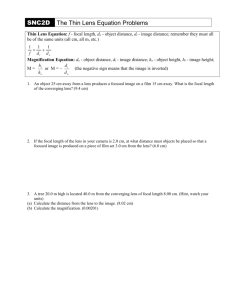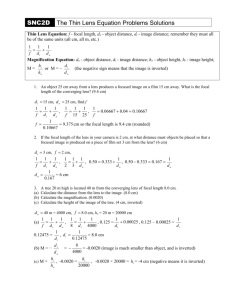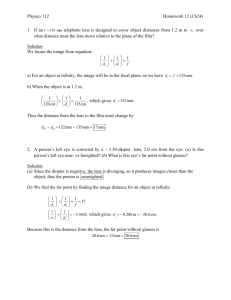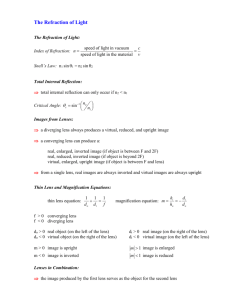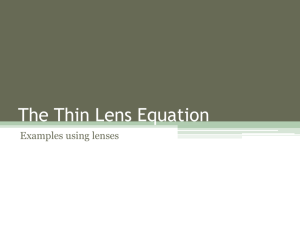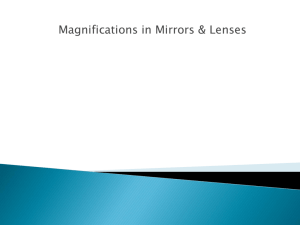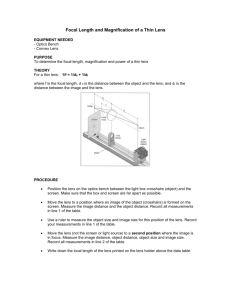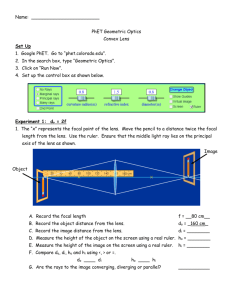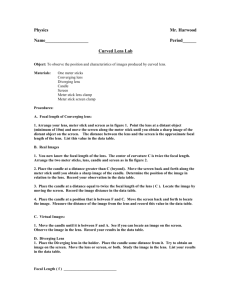Phys 102 * Lecture 2
advertisement
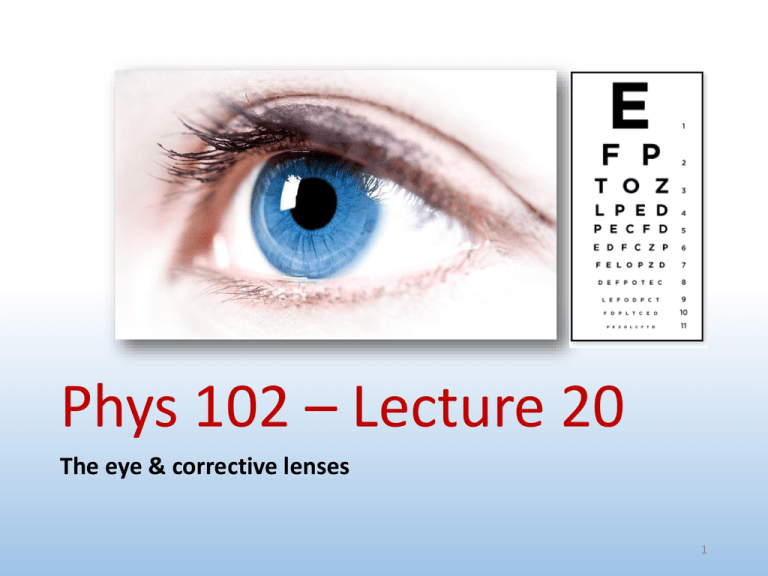
Phys 102 – Lecture 20 The eye & corrective lenses 1 Today we will... • Apply concepts from ray optics & lenses Simple optical instruments – the camera & the eye • Learn about the human eye Accommodation Myopia, hyperopia, and corrective lenses • Learn about perception of size Angular size Magnifying glass & angular magnification Phys. 102, Lecture 19, Slide 2 The Camera Cameras are one of simplest optical instruments, produce real image onto sensor Pinhole camera (“camera obscura”) Pinhole DEMO Not a true imaging system. Each point from object creates a circle of light on screen. Modern camera Imaging lens 1 1 1 d o di flens True imaging system. Each point from object has a corresponding point on screen. Phys. 102, Lecture 20, Slide 3 Evolution of the eye The eye is like a camera Pinhole eye Nautilus Complex eye Octopus Phys. 102, Lecture 20, Slide 4 Anatomy of the human eye As in a camera, eye lens creates image of object onto retina Ciliary muscles Cornea Vitreous fluid Pupil Lens Part of eye n Cornea Lens Vitreous fluid 1.351 1.437 1.333 Retina Iris Optic nerve Pupil controls amount of light – diameter typically 2-8 mm DEMO Retina has ~125 million photoreceptor cells (rods & cones) Phys. 102, Lecture 20, Slide 5 ACT: Anatomy of the Eye Which part of the eye is responsible for most of the bending of light? Cornea Laser eye surgery changes cornea! A. Lens Vitreous fluid Retina Lens B. Cornea C. Retina Part of eye n Cornea Lens Vitreous fluid 1.351 1.437 1.333 D. Vitreous fluid Shape and index of refraction mismatch determine how much light bends: Lens and cornea have similar shape and n nlens 1.44 nlens 1.44 ncornea 1.35 1.08 1.06 1.35 n 1.33 ncornea 1.35 nair 1 vitreous Most of bending occurs at air-cornea interface Phys. 102, Lecture 20, Slide 6 Accommodation Ciliary muscles around lens change its shape and focal length The eye can focus on objects both close and far ≈ Ciliary muscles Distant object Image Close object “Relaxed” “Tensed” lens The “far point” and “near point” are the maximum and minimum object distances where the image remains in focus Far point: do,far = ∞ Near point: do,near = 25 cm Normal adult DEMO Phys. 102, Lecture 20, Slide 7 Calculation: focal length of the eye An adult with normal eyesight will see a focused image over a wide range of object distances: Object “Far” point: do,far = ∞ di “Near” point: do,near = 25 cm do Image Typical lens-retina distance = 2.0 cm What are the focal lengths of the relaxed and tensed eye? 1 f relaxed 1 do, far f relaxed 2.00cm 1 1 1 di 2.0 cm 1 ftensed 1 do,near 1 1 1 di 25cm 2.0 cm ftensed 1.85cm Small change in f yields large charge in do! Phys. 102, Lecture 20, Slide 8 ACT: CheckPoint 1 A person with almost normal vision (near point at 26 cm) is standing in front of a plane mirror. What is the closest distance to the mirror where the person can stand and still see himself in focus? 13 cm 47 % A. 13 cm 44 % B. 26 cm 8 % C. 52 cm 13 cm Image from mirror becomes object for eye! Phys. 102, Lecture 20, Slide 9 Near Point, Far Point • Eye’s lens changes shape (changes f ) Object at any do should produce image at retina (di ≈ 2.0 cm) Lens can only change shape so much • “Far Point” Furthest do where image can be at retina Normally, dfar = ∞ (if nearsighted then closer) • “Near Point” Closest do where image can be at retina Normally, dnear ≈ 25 cm (if farsighted then further) Phys. 102, Lecture 20, Slide 10 Myopia (nearsightedness) If nearsighted, far point dfar < ∞ Image Distant object Far point Object at do > dfar creates image in front of retina Corrective lens creates image of distant object at the far point of the nearsighted eye 11 1 1 do d far flens flens d far Diverging lens! flens such that distant object at ∞ (“normal” far point) is in focus DEMO Phys. 102, Lecture 20, Slide 11 Hyperopia (farsightedness) If farsighted, near point dnear > 25 cm Image Near point Close object Object at do < dnear creates image behind retina Corrective lens creates image of close object at the near point of the farsighted eye 11 1 1 do d near 25cm flens dnear 25cm so flens 0 flens such that object at 25 cm (“normal” near point) is in focus DEMO Converging lens! Phys. 102, Lecture 20, Slide 12 ACT: Corrective lenses For which type of eye correction is the image always virtual? Nearsighted eye A. Nearsighted B. Farsighted C. Both D. Neither Farsighted eye In both cases the image is formed before the lens, so it is virtual! Also, image is upright, reduced (diverging lens) or enlarged (converging lens) Phys. 102, Lecture 20, Slide 13 Calculation: Refractive Power Optometrists use refractive power P instead of focal length f 1 P f Units: “Diopters” (D) 1/meters Your friend’s contact lens prescription is –3.3 diopters. What is the focal length? Is your friend near- or farsighted? flens 1 1 0.3 m 30 cm 3.3 D P d far flens 30 cm A diverging lens! Your friend is nearsighted Phys. 102, Lecture 20, Slide 14 ACT: Refractive power A relaxed, normal eye has a refractive power Pnorm: Pnorm 1 f norm 1 50 D 0.02 m How does the refractive power Pmyopic of a relaxed, nearsighted eye compare? Nearsighted eye forms an image of a distant object in front of retina so f must be smaller, P larger A. Pmyopic > +50 D B. Pmyopic = +50 D C. Pmyopic < +50 D Alternately, 1 1 1 Pnorm 0.02 m f norm 1 1 1 Pmyopic Pnorm d far 0.02 m f myopic Phys. 102, Lecture 20, Slide 15 ACT: CheckPoint 2 Two people who wear glasses are camping. One of them is nearsighted and the other is farsighted. Which person’s glasses will be useful in starting a fire with the sun’s rays? A. Nearsighted 33 % B. Farsighted 67 % Farsighted person’s glasses are converging – like magnifying glass! Phys. 102, Lecture 20, Slide 16 Astigmatism A normal eye is spherical, curved the same in every direction An astigmatic eye is distorted (oval) along one direction Rays from vertical object Vertical Image Rays from horizontal object Horizontal Image So, an astigmatic eye has a different f along different directions Images are blurry in one direction Corrected with toric lens Phys. 102, Lecture 20, Slide 17 Angular Size: CheckPoint 3.1-3.2 Angular size refers to how large the image is on your retina, and how big it appears to be. ho θ θ θ' θ' do Both objects are same size, but nearer one looks bigger. ho (in radians) if angle is small tan θ do What is the maximum possible angular size? θmax ho d near Phys. 102, Lecture 20, Slide 18 Calculation: Angular size A cameraman takes a trick shot of the Eiffel tower, which is 300 m tall. How far is the cameraman from the Eiffel tower? (Assume the camera is 30 cm from his hand.) h = 10 cm 300m θ 0.3m h = 0.1m x 0.1 300 tan θ 0.3 x x 900 m Phys. 102, Lecture 20, Slide 19 Magnifying glass A magnifying glass produces a virtual image behind object, allowing a closer object do < dnear and a larger θ′ θ hi Virtual ≈ image hθo Near point –di θ' hi ho di d o θmax max do Angular magnification gives how much angular size increases: d near ho do θ M dfo θmax ho d near Typically set image at di = ∞, for a relaxed eye (so do = f) Phys. 102, Lecture 20, Slide 20 ACT: Magnifying glass A person with normal vision (dnear = 25 cm, dfar = ∞) has a set of lenses with different focal lengths. She wants to use one as a magnifying glass. Which of the following focal lengths will magnify the image? A. B. C. D. f = 50 cm f = 2.5 cm f = –6 cm f = –40 cm Magnifying glass is a converging lens (f > 0) Want f < dnear to magnify d near M f DEMO Phys. 102, Lecture 20, Slide 21 Summary of today’s lecture • Accommodation – eye lens changes shape Near point – closest object (~25 cm, further if farsighted) Far point – furthest object (∞, closer if nearsighted) • Corrective lenses Nearsighted – diverging lens creates virtual image at far point Farsighted – converging lens creates virtual image at near point • Angular size & angular magnification Magnifying glass creates virtual image of object placed closer than near point Phys. 102, Lecture 20, Slide 22
